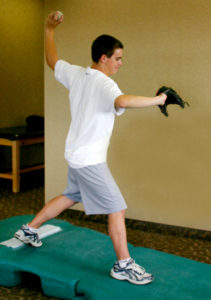 This is a common question in my practice and worth the effort here to describe the normal process of which the “lug nuts” of the shoulder girdle slowly wear as the years go by. The symbolism of lug nuts is highly appropriate noting that the four rotator cuff muscles serve to hold the ball in the socket via compression thus maximizing rolling while simultaneously limiting shear (the sliding of the ball on the socket).
This is a common question in my practice and worth the effort here to describe the normal process of which the “lug nuts” of the shoulder girdle slowly wear as the years go by. The symbolism of lug nuts is highly appropriate noting that the four rotator cuff muscles serve to hold the ball in the socket via compression thus maximizing rolling while simultaneously limiting shear (the sliding of the ball on the socket).
Taking Muscles for Granted
We tend to take these “non-mirror” muscles for granted , failing to appreciate how they maintain the functional mechanics of the ball and socket joint as larger muscles around the shoulder girdle go about their business of pushing, pulling and lifting. This ambivalence ends abruptly once the rotator cuff becomes damaged and dysfunctional. With the proliferation of upper extremity sport (and intensity thereof), the endless hours with arms positioned at a keyboard, and the better appreciated requirements of the common laborer with overhead lifting; the prevalence of rotator cuff pathology has become commonplace in this country.
The result can be highly impairing with the inability to raise the arm overhead while being unable to accomplish the simplest of lift activities, i.e. feeding oneself or brushing teeth. On the other hand, the majority of 60 and 70 year olds have a rotator cuff tear and most go about their business completely unaware. In this scenario, the person has been able to maintain more normative functional mechanics about the shoulder girdle thus minimizing the day to day compressive trauma to the rotator cuff. The restoration of more normative mechanical function is a primary goal of conservative physical therapy care and can prevent or prolong the need for surgical intervention.
Less than 10 mm usually separate the undersurface of the bony roof of the shoulder (where the collar bone and shoulder blade meet to form a joint) and the ball which sits in the adjacent socket. In this space is positioned the majority of the rotator cuff tendon mass and a protective bursa.
Wear & Tear Over Time
Over the course of a lifetime with varied mild to moderate insults, the body responds by slowly tightening the ligamentous structure and joint capsule (which holds the lubricating fluid of the joint) that attaches the ball to the socket; i.e. it’s tougher to wash/scratch your back than in days gone by. With this progression, the ball tends to migrate upward diminishing the relative space between the ball and roof above further entrapping the rotator cuff tendons. This is most noted with attempts at overhead activity noting that we appreciate that maintaining an overhead tennis serve is more difficult than maintaining a golf swing,
With repetitive mid-range activity, i.e. using a keyboard extensively at work, working as a house painter or traumatic incident i.e. a fall on the ice where the arm is driven overhead, the rotator cuff can become damaged. A history of overuse with adolescent/adult throwing or racquet sports will further hasten the degenerative process. Focal degenerative change on the undersurface of the bony roof further complicate, acting like sandpaper rubbing on the rotator cuff immediately below. In a country that is upper extremity sport dominant, one can appreciate the high propensity for this type of injury.
So how does one optimize function and minimize the seemingly inevitable regression. The answer lies in maintaining normative functional mobility about the ball and socket joint, maintaining functional strength about the muscles that control the gliding of the shoulder blade on the thorax and not forgetting to spend a little time at the health club isolating the four rotator cuff muscles. A program such as this is not that time consuming and can be implemented in 1 or 2 visits. Introduction of such a program in during the 3rd or 4th decade of life will pay dividends in one’s later years.
- Staying Fit While Aging - July 3, 2023
- How Much Exercise do You Need to Stay Healthy? - September 21, 2022
- Even a Small Amount of Exercise can Have Huge Benefits for Our Bodies - March 16, 2022
